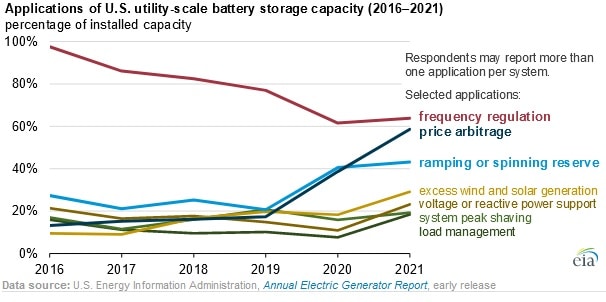U.S. Utility-Scale Battery Capacity Tripled in 2021: EIA

U.S. utility-scale battery capacity grew by 229 percent between 2020 and 2021, reaching 4.6 gigawatts, according to a July 27 report from the U.S. Energy Information Administration. Battery power capacity more than tripled during 2021, with more than 93 percent of the installations co-located with solar power plants.
U.S. Utility Battery System Application:
To better understand battery usage, the agency conducted a survey on the application of battery systems in which respondents were allowed to cite more than one usage of a battery system. Survey results indicated that battery systems are widely used in price arbitrage, a strategy whereby battery systems are used to store electric energy at lower prices and discharge electric energy at higher prices. About 2.7 gigawatts were used in price arbitrage, which accounts for 59 percent of the U.S. utility-scale battery capacity in 2021. Next, battery systems are utilized to maintain grid reliability as they can swiftly absorb power surges. Battery storage is used to regulate grid frequency, which is the most common application of battery systems in the U.S., so that the frequency is maintained at 60 cycles per second.
Drivers of Capacity Growth:
Among the key drivers, there is an increasing need for energy storage in energy-shifting applications due to growing renewables on the grid. Moreover, there is a change in regulations that have allowed regional power markets to update their policies to permit storage to completely participate in energy markets. Other growth drivers are increased penetration of renewables and deployment targets at the state level.
Though pumped hydropower storage projects account for the majority of installed energy storage capacity in the United States, non-hydro power lithium-ions, primarily lithium ion batteries, have led the way in terms of new energy storage capacity since 2011. New energy storage capacities paired with renewables are becoming the most cost-effective way to switch from fossil fuels.
California leads the nation in utility-scale lithium-ion battery deployment in the US. Texas is the second largest market for battery storage systems. Solar energy penetration in California and wind energy penetration in Texas make these two states attractive markets for larger batteries.
EnerKnol Pulses like this one are powered by the EnerKnol Platform—the first comprehensive database for real-time energy policy tracking. Sign up for a free trial below for access to key regulatory data and deep industry insights across the energy spectrum.
ACCESS FREE TRIAL